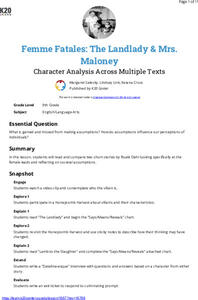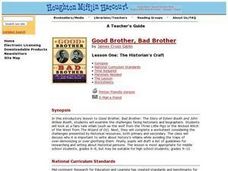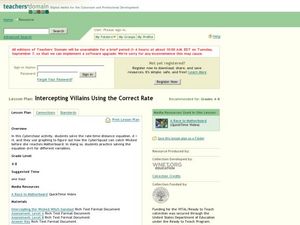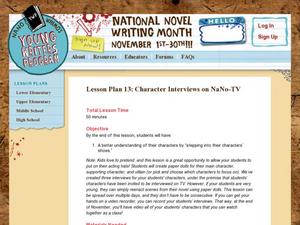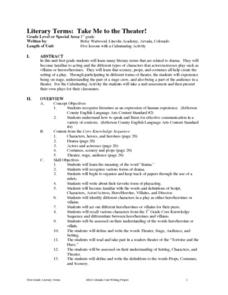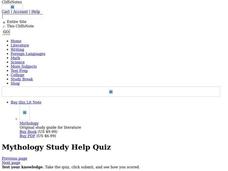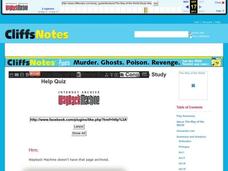Penguin Books
A Teacher's Guide to the Signet Classics Edition of William Shakespeare's Richard III
Villainy, parricide, ambition, abuse of power, and some of the most famous lines in English literature—Richard III has it all. Instructors using the play for the first time and those who list it as one of their favorites will find the...
Penguin Books
Educator's Guide: The Da Vinci Code by Dan Brown
Dan Brown's The Da Vinci Code is filled with secrets. Help readers find the clues, solve the riddles and puzzles, and unwrap the mysteries with a six-page guide that includes before, during, and after reading discussion questions and...
K20 LEARN
Femme Fatales - The Landlady and Mrs. Maloney: Character Analysis Across Multiple Texts
Two stories by Roald Dahl, "Lamb to the Slaughter" and "The Landlady" provide readers an opportunity to compare stories by the same author. After a close reading of the stories, teams select a character from one of the tales, craft...
PBS
Frankenstein: The Consequence of Creation
Famous as a horror story, as the first science fiction novel, Frankenstein is also a tale of ambition, a warning about unbridled science, and responsibility for actions. Readers consider what the tale says of the consequences of creation...
Curated OER
Descriptive Writing
Second graders analyze descriptive writing. In this writing instructional activity, 2nd graders read a story with a villain, describe the villain in words, and create a Wanted Poster describing him on paper.
Curated OER
Persuasion
Middle schoolers read various stories and write reflections in their journals. Using the text, they identify the techniques the characters used in persuading the reader or other characters in the story.They rewrite a fairy tale from the...
Curated OER
The Battle of Good and Evil on the Big Screen
Students evaluate how the movie industry depicts heroes, villains, and events, and how these characters and plots relate to the society and time period in which the films are created.
Curated OER
Lesson One: The Historian's Craft
Learners examine a fairy tale villain (such as the wolf from the Three Little Pigs or the Wicked Witch of the West from The Wizard of Oz). Next, they complete a worksheet considering the challenges presented by historical resources.
Curated OER
Intercepting Villans Using the Correct Rate
A Cyberchase video introduces the distance = rate x time equation. Participants then calculate answers to proposed problems and graph a series of results that is then incorporated into a game to help cement the concept. A thorough and...
Curated OER
The Nature of the Antagonist
Students explain the differences between protagonists and antagonists and recognize the fundamental purpose of an antagonist or villain in storytelling. They also explain conflict as used in literature.
Curated OER
The Antagonist's Point of View
Analyzing literary antagonists is a first step to creating memorable characters in student writing.
Curated OER
Classroom Guide for the Redwall Series
Students participate in cross-curricular activities and readings to become familiar with the works of Brian Jacques. In this heroes lesson, students discuss the character traits of legends and how their characters develop through events...
Curated OER
The 1:1 Transition: What to Read Before You Implement
Capitalize on the wisdom, experience, and recommendations of those who have blazed the 1:1 trail.
Media Literacy
Good Versus Evil: Exploring Popular Children's Animation
Dora, Buzz Lightyear, Mufasa. Swiper, Dr. Porkchop, Scar. The six lessons in this unit packet focus on how good and evil, and violence, are portrayed in children's animation. The lessons encourage kids to consider how violence is...
Smithsonian Institution
Mobilizing Children
Scholars find out how the government used propaganda to mobilize children to help in the war effort. Lesson exercises include analyzing a quote from Franklin Roosevelt, viewing propaganda images and posters, and participating in a lively...
Curated OER
Lesson Plan 13: Character Interviews on NaNoTV
Kids love to pretend. Use this imaginative energy to develop their understanding of characterization. Class members dress up as a character from their novel-writing project and sit for a filmed interview. In responding to questions about...
Curriculum Corner
Fairy Tale Unit of Study
What makes a fairy tale a fairy tale? Use a 27-page packet to supplement your next fairy tale unit. With sequencing activities, story map worksheets, character analyses and story elements graphic organizers, and fairy tale highlight...
Curated OER
I'm a Changed Pig - Personal Narrative
Young writers explore character arcs, conflict, and narrative in this complete and ready-to-use lesson plan from Scholastic. As a class read The Three Little Wolves and the Big Bad Pig and discuss the dramatic change the pig undergoes...
Curated OER
Literary Terms: Take Me to the Theater!
Take your class to the theater! First graders will examine characters that actors play such a villians and heroes. Then participate in creating plays and performing in them. They will also research what it takes to create scenery, props...
Curated OER
Guess My Shape
Learners play a game with shapes. They work in groups to identify the names and characteristics of various shapes. They give each other clues to see if others can identify the shape being described. This is a great hands on activity.
Curated OER
Mythology Study Guide
After exploring the wonderful world of mythology, give your high schoolers this multiple choice quiz to assess their ability to recall pertinent information. There are 15 questions posed, and users can press "submit" to receive immediate...
Curated OER
The Way of the World By William Congreve
In this online interactive reading comprehension worksheet, students respond to 15 multiple choice questions based on The Way of the World. Students may submit their answers to be scored.
Curated OER
The Worldly Philosophers by Robert Louis Heilbroner
CliffsNotes provides a list of study questions to help your high schoolers grapple with The Worldly Philosophers. Some of them are simple and straight forward, while others offer an opportunity to dig in deeper! Consider printing this...
Curated OER
Antonyms 3
Identifying the antonyms for vocabulary you're learning will definitely help ensure a deeper understanding. There are 10 words included, and a detailed answer sheet. Example words include climax, resolute, and ajar.
Other popular searches
- Christopher Columbus Villain
- Heroes and Villains
- Modern Heroes Villains
- Marlowe Villains
- Villains History
- Heroes Villains
- Fairy Tale Villains
- Beowulf Heroes and Villains
- Villains in Myths and Legends
- Villains and Science
- Film Villains
- Columbus Hero of Villain




